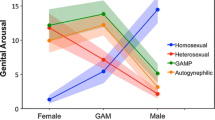Abstract
The risks associated with sexual activity relate in part to the pathophysiology of the cardiovascular response to sexual activity. This review addresses this subject and reviews studies that directly address the cardiovascular risk associated with sexual activity.
Similar content being viewed by others
References and Recommended Reading
Masters WH, Johnson VE: Human Sexual Response. Boston: Little, Brown & Co.; 1966. This book represents one of the early studies that demonstrated a significant increase in heart rate and blood pressure (systolic and diastolic) during sexual activity in a laboratory setting.
Becker AJ, Ukert S, Stief CG, et al.: Plasma levels of cavernous and systemic norepinephrine and epinephrine in men during different phases of penile erection [abstract]. Akt Urologie Urologe 1999, 38:S124. This study measured the systemic and cavernous levels of norepinephrine and epinephrine during penile erection. These levels were not suggestive of significant cardiovascular stress during sexual activity.
Bartlett RG, Jr: Physiologic responses during coitus. J Appl Physiol 1956, 9:469–472.
Hellerstein HK, Friedman EH: Sexual activity and the postcoronary patient. Arch Intern Med 1970, 125:987–999. These authors published, for the first time, "l patient-real life Setting"ta on coital heart rates in middle-aged men with coronary artery disease. Myocardial oxygen cost of the sexual activity was suggested to be equivalent to climbing two flights of stairs.
Namec ED, Mansfield L, Kennedy JW: Heart rate and blood pressure responses during sexual activity in normal males. Am Heart J 1976, 92:274–277.
Stein RA: The effect of exercise training on heart rate during coitus in the post myocardial infarction patient. Circulation 1977, 55:738–740. This paper noted the role of endurance exercise training and the associated increase in aerobic capacity (VO2m) in the reduction of peak coital heart rates following a 16-week program.
Sanderson MO, Held JP, Bohlen JG: Heart rate during masturbation. J Cardiac Rehab 1982, 2:542–546.
Bohlen JG, Held JP, Sanderson MO, et al.: Heart rate, ratepressure product, and oxygen uptake during four sexual activities. Arch Int Med 1984, 144:1745–1748. Authors studied heart rates, blood pressure, and VO2 in healthy men during four specified sexual activities, two coital and two noncoital. They concluded that higher energy expenditures were required during coital acts compared with noncoital, and peak levels were attained during orgasm.
Mann S, Craig MWM, Gould B, et al.: Coital blood pressure in hypertensives [abstract]. Circulation 1980 62 (suppl. III):37.
Cantwell JD: Sex and the heart. Med Aspects Hum Sexual 1981, 15:14–23.
Mittleman MA, Maclure M, Sherwood JB, et al.: Triggering of acute myocardial infarction onset by episodes of anger: Determinants of Myocardial Infarction Onset Study Investigators. Circulation 1995, 92:1720–17125. These investigators studied the activities (by recall during an interview on the day of their MI) that preceded their MI and during a prior non-MI day. Coitus was noted to be more common in the 2 hours preceding the MI than on the non-MI day, as was an episode of anger or of physical exertion.
Mittleman MA, Maclure M, Tofler GH, et al.: Triggering of acute myocardial infarction by heavy physical exertion. Protection against triggering by regular exertion. Determinants of Myocardial Infarction Onset Study Investigators. N Engl J Med 1993, 329:1677–1683.
Muller JE: Sexual activity as a trigger for cardiovascular events: what is the risk? Am J Cardiol 1999, 84:2N-5N.
Ueno M: The so-called coition death. Jap J Legal Med 1963, 17:330–340.
Lecomte D, Fornes P, Nicolas G: Stressful events as trigger of sudden death: a study of 43 medico-legal autopsy cases. Forensic Sci Int 1996, 79:1–10.
Jackson G: Sexual intercourse and angina pectoris. Int Rehab Med 1981, 3:35–37.
Muller JE, Mittleman A, Maclure M, et al.: Triggering myocardial infarction by sexual activity. Low absolute risk and prevention by regular physical exertion. Determinants of Myocardial Infarction Onset Study Investigators. JAMA 1996, 275:1405–1409. This paper concluded that sexual activity can trigger acute MI. However, relative risk and absolute risk are low and extremely low, respectively. The study also noted a reduced relative risk of coitus triggering an acute MI in patients who exercised regularly, suggesting role of exercise training in reducing the risk of triggering an MI with coitus.
Drory Y, Shapira I, Fisman EZ, et al.: Myocardial ischemia during sexual activity in patients with coronary artery disease. Am J Cardiol 1995, 75:835–837. This paper demonstrated a moderate incidence of ischemia during sexual activity in patients with coronary artery disease, and noted that the majority of such patients had an ischemic response to exercise EKG testing.
Johnston BL, Fletcher GF: Dynamic electrocardiographic recording during sexual activity in recent post-myocardial infarction and revascularization patients. Am Heart J 1979, 98:736–741.
Drory Y, Fisman EZ, Shapira Y, et al.: Ventricular arrhythmias during sexual activity in patients with coronary artery disease. Chest 1996, 109:922–924. This study illustrated no significant increase in arrhythmias during sexual activity among most subjects (married couples or permanent partners). However, they did note that there were complex ectopic arrhythmias during coitus in 25% of patients with coronary artery disease.
Paolillo V, Marra S, Chiappa E, et al.: Influence of sleep, wakefulness and some daily activities on ventricular ectopic activity in recent myocardial infarction. Giornale Italiano di Cardiologia 1981, 11:12–22.
Davey SG, Frankel S, Yarnell J: Sex and death: are they related? Findings from the Caerphilly cohort study. Br Med J 1997, 315:1641–1644.
Palmore EB: Predictors of longevity difference: a 25-year follow-up. Gerontologist 1982, 22:513–518.
Kaplan SD: Retrospective cohort mortality study of Roman Catholic priests. Prev Med 1988, 17:335–343.
Author information
Authors and Affiliations
Rights and permissions
About this article
Cite this article
Safi, A.M., Stein, R.A. Cardiovascular risks of sexual activity. Curr Psychiatry Rep 3, 209–214 (2001). https://doi.org/10.1007/s11920-001-0054-6
Issue Date:
DOI: https://doi.org/10.1007/s11920-001-0054-6




